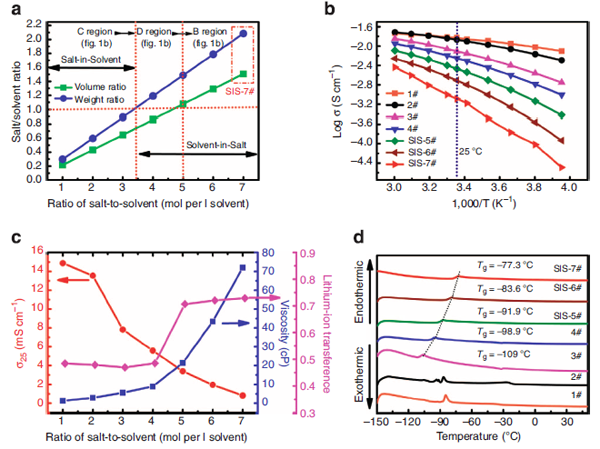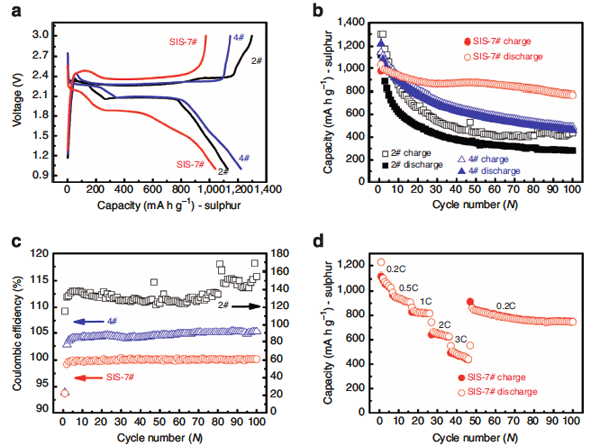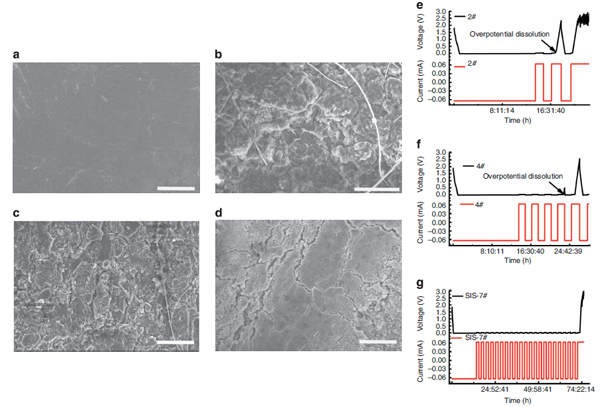 |
Figure 1: A new dual-function Solvent-in-Salt electrolyte solution for lithium-sulfur batteries

Figure 2: Physico-chemical properties of Solvent-in-Salt (LiTFSI in DOL-DME) system.

Figure 3: SIS system for electrochemical performance of lithium-sulfur batteries.

Figure 4A: Multi-sulfide dissolution experiment

Figure 4B: Multi-sulfide dissolution experiment

Fig. 5: Surface morphology changes of metal lithium anodes after long cycles of different electrolyte systems
Lithium battery system is favored as an efficient energy storage device and has been widely used in portable electronic devices (mobile phones, notebooks, etc.), and is currently being applied to new energy electric vehicles, smart grids, and clean energy (wind and solar energy) on a large scale. Energy storage, thereby reducing human over-reliance on fossil energy, reducing carbon dioxide and related waste emissions, reducing the impact of greenhouse gases on the global climate and air pollution in cities.
As people's demands for daily-use electronic consumer products and electric vehicles continue to increase, there is an urgent need to develop higher energy density battery systems. The theoretical energy density of lithium-sulfur secondary batteries (Li-S batteries) at room temperature is 2654 Wh/kg, which is the theoretical energy density of lithium-ion batteries (LiCoO2/C, delithiation 0.5, theoretical energy density 360 Wh/kg). 7 times. Rechargeable lithium-sulfur batteries are expected to have an energy density of 350-400 Wh/kg, which is expected to significantly increase the cruising range of electric vehicles. The two core technical problems that restrict the application of rechargeable lithium-sulfur batteries are: how to suppress the dissolution of intermediate polysulfide ions during charging and discharging, and how to stabilize the lithium metal anode to avoid the production of lithium dendrites.
Recently, Institute of Physics, Chinese Academy of Sciences/Beijing National Laboratory for Condensed Matter Physics (CPC) E01 group Hu Yongsheng, a researcher and Ph.D. student Suo Min, proposed a new type of dual-function electrolyte system Solvent-in-Salt. "(SIS), and its application in lithium-sulfur batteries, at the same time solve the two key technical problems of polysulfide ion dissolution and stable metal lithium negative electrode. By substantially increasing the lithium salt concentration, a large number of free solvent molecules are complexed with the lithium salt, thereby effectively suppressing the dissolution of polysulfide ions in the electrolyte, and effectively avoiding the formation of polysulfide ions dissolved in the electrolyte during charging. The "ion shuttle" effect prevents serious overcharging of the battery. The circulating coulombic efficiency is close to 100% and the cycle stability is significantly improved. At the same time, compared to conventional low-salt electrolyte systems, high-salt electrolyte systems have high concentrations of anions and cations (7 mol LiTFSI / 1 L DOL-DME), high lithium ion migration (0.73), and comparison. The high viscosity (72 cP) effectively avoids the growth of metal lithium dendrites due to the non-uniform deposition of metallic lithium (high lithium ion concentration favors the homogeneous material exchange of metallic lithium negative electrode; high anion concentration and viscosity help In order to reduce the space charge layer generated on the surface of metal lithium negative electrode due to anion depletion, the electric field driving force for non-uniform deposition of metallic lithium is reduced; high-viscosity system increases the resistance of lithium dendrite growth to a certain extent.) The stability of the lithium negative electrode during cycling is greatly improved.
The results of relevant studies were published in the recent [Nature Communications, 4, 1481, DOI: 10.1038/ncomms2513 (2013)].
The above work has received strong support from the Energy Innovation Materials Research and Innovation Team of the Ministry of Science and Technology, the Science and Technology Innovation Project Energy Project Group Directional Project, the 100-member Academy of Science Program, and the Foundation.
Industrial Turnbuckle,Commercial Maleable Turbuckle,JIS Frame Turnbuckle
Shackles,Hook,Link Chain Co., Ltd. , http://www.goshardware.com